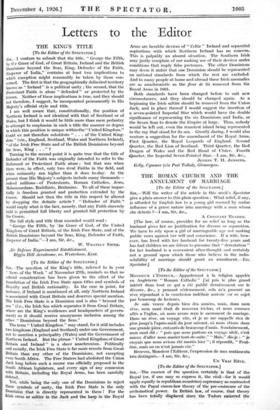[To the Editor of the SPECTATOR.] SIR,—The queition of the
King's title, referred to in your News of the Week " of November 27th, reminds us that no official consideration has been given to the effect of the foundation of the Irish Free State upon titles and symbols of Royalty and British nationality. In the case in point, for instance, if Ireland is mentioned at all, only Northern Ireland is associated with Great Britain and deserves special mention. The Irish Free State is a Dominion and is also " beyond the sea" (i.e., the Irish Sea which separates it from Great Britain, where are the King's residences and headquarters of govern- ment) so it should receive anonymous inclusion among the other " Dominions beyond the Seas."
The term " United Kingdom " may stand, for it still includes two kingdoms (England and Scotland) under one Government, not to mention a principality (Wales) and the Government of Northern Ireland. But the phrase " United Kingdom of Great Britain and Ireland " is a sheer anachronism. Politically and racially, the Irish Free State is far more remote from Great Britain than any other of the Dominions, not excepting even South Africa. The Free Stators had abolished the Union Jack long before such a course was officially proposed in the South African legislature, and every sign of any connexion with Britain, including the Royal Arms, has been carefully deleted.
Yet, while being the only one of the Dominions to reject these symbols of unity, the Irish Free State is the only Dominion that is directly represented in them ! For the Irish cross or saltire in the Jack and the harp- in the Royal Arms are heraldic devices of " Celtic " Ireland and separatist aspirations with which Northern Ireland has no concern. This is palpably an absurd situation. The Southern Irish may justly complain of our making use of their devices under conditions that imply false pretences. The other Dominions may deem it unfair that one Dominion should be represented on national standards from which the rest are excluded. And to many people at home and abroad these Irish anomalies are as anachronistic as the fleur de lis removed from the Royal Arms' in 1801.
Both standards have been changed before to suit new circumstances, and they should be changed again. As a beginning the Irish saltire should be removed from the Union Jack, and in place thereof I would suggest the insertion of a seven-pointed Imperial Star which would have the double significance of representing the six Dominions and India, or the Seven Seas to denote the Empire at large. Thus, nobody would be left out, even the remotest island being represented in the ray that stood for its sea. Greatly daring, I would also venture a suggestion for the amendment of the Royal Arms. First Quarter, the Royal Leopards of England. Second Quarter, the Red Lion of Scotland. Third Quarter, the Red Dragon of Wales and the Red Hand of Ulster. Fourth Quarter, the Imperial Seven-Pointed Star.—I am, Sir, &e., JENKIN T. H. JENKINS.
Getty, Cymmer (via Port Talbot), Glamorgan.






























































 Previous page
Previous page